Manet und Astruc. Künstlerfreunde
Reviewed by Martin SchulzMartin Schulz
Art History Professor at University of Arts Bremen
Email the author: mschulz[at]hfk-bremen.de
Citation: Martin Schulz, exhibition review of Manet und Astruc. Künstlerfreunde, Nineteenth-Century Art Worldwide 21, no. 1 (Spring 2022), https://doi.org/10.29411/ncaw.2022.21.1.20.
This work is licensed under a Creative Commons Attribution-NonCommercial 4.0 International License  unless otherwise noted.
unless otherwise noted.
Your browser will either open the file, download it to a folder, or display a dialog with options.
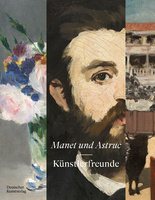
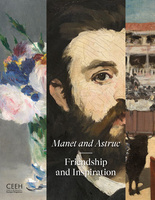
Manet und Astruc. Künstlerfreunde
Kunsthalle Bremen
October 23, 2021–February 27, 2022
Catalogue:
Dorothee Hansen, ed.,
Manet und Astruc. Künstlerfreunde.
Berlin and Munich: Deutscher Kunstverlag, 2021.
320 pp.; 286 color illus.; bibliography; chronology; notes & references; index.
€ 54 (hardcover)
ISBN–10: 3422987606
ISBN–13: 978–3422987609
English Catalogue:
Dorothee Hansen, ed.,
Manet and Astruc: Friendship and Inspiration.
Madrid: CEEH, 2021.
320 pp.; 286 color illus.; bibliography; chronology; notes & references; index.
€ 32,69 (softcover)
ISBN–13: 978–84–18760–02–0
One of the special highlights of the many international exhibitions that came to fruition during the winter of 2021–22 despite the ongoing pandemic is without question Manet und Astruc. Künstlerfreunde (Manet and Astruc: Friendship and Inspiration) at the Kunsthalle Bremen, conceived, prepared, and curated with many remarkable loans by Dorothee Hansen, Deputy Director and Curator of Painting at the Kunsthalle. She is also the editor of the comprehensive catalogue, richly illustrated with color pictures, and has written essential texts in it.
The exhibition’s subtitle, Künstlerfreunde (Friendship and Inspiration), and the inclusion of many Freundschaftsbildern (friendship pictures), highlights an important theme in modern art that can be traced back to the allegorical painting Italia and Germania (1828) by Friedrich Overbeck and reaches ahead to the busts of Gerhard Richter and Blinky Palermo (1971–84), who face each other at eye level and in intimate proximity in the Lenbachhaus in Munich. Collective and friendly collaboration in related aesthetic and intellectual intentions, in a network of mutually supportive, like-minded people who transcend academic norms, reorient them, and, not least, expand them interculturally—these are contemporary ideals that also characterized precisely this early phase of a modern art turned towards life and its reality.
At the epicenter of this narrowly chronological but thematically far-reaching exhibition is the Portrait of Zacharie Astruc by Édouard Manet from 1866 (figs. 1–2, left), one of the masterpieces of the Kunsthalle Bremen acquired by its first director Gustav Pauli with the help of the Kunstverein in 1909. The painting is among the most important works of modern art not only in its colorfulness and style, but also in its manifold references to Titian, Velásquez, Dutch still life, Spanish painting, and Japanese art and culture. It is therefore one of the contradictions of art history that this work was exhibited only once during Manet’s lifetime and otherwise remained in his studio without a frame after the artist’s early death in 1883.
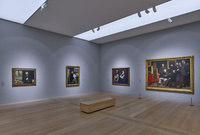
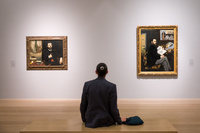
The Portrait of Émile Zola, which Manet painted two years later in 1868 (and which is also one of the generous loans of the Musée d’Orsay for this exhibition), is quite different (fig. 2, right). It became famous shortly after its creation and contributed to the reputation of the then still largely unknown French writer. Both portraits, of Astruc and Zola, seem superficially similar and yet, as Hansen subtly points out in her introductory catalogue essay, show striking differences: Astruc’s portrait, which also carries references to Manet’s Olympia—the painting that provoked a scandal at the Salon of 1865 in which the artist and the writer were both involved—is an intimate and private portrait of friendship, in which the sitter looks at the viewer, whereas Zola’s portrait has a more representative character and can be seen as an obvious thank-you to Zola, who had written a text about Manet. Common to both paintings, however, is an aesthetic program whose new intercultural coordinates of Spanish and Japanese art are spread out across the exhibition. The return to existing European traditions as well as emerging Japanese influence are made clear in many of Manet’s paintings: from the legendary Spanish dancer Lola de Valence, with whom Astruc was also fascinated, to bullfighting, to the many borrowings from the revered masters Velásquez and Goya, whose works were incessantly copied and quoted. Furthermore, there are outstanding works of Japanese art from the nineteenth century, above all by Hokusai, which caused enthusiasm in Paris in the 1860s and whose inspiration for Manet as well as for Astruc can hardly be overestimated: as exotic magic in the interior of one’s own culture. The formal reduction, the bright colors, and the emphasis on the surface found in Japanese art were appreciated as common transcultural qualities and as aesthetic virtues of a modern painting as well. The Japanese woodcuts are beautifully complemented by decorative screens and play dolls.
While Manet’s portrait of Astruc remained unknown for a long time, it nevertheless made an appearance in an indirect and rather hidden way in A Studio in the Batignolles Quarter, exhibited by Henri Fantin-Latour at the Paris Salon in 1870 and another top-class loan from the Musée d’Orsay in this exhibition. It shows Manet himself in the center, concentrating on painting Astruc, who sits as a model. Of the picture, we see only the back of its canvas. There is little doubt, however, that the work being painted is the very one at the center of the exhibition. It is not the finished portrait that is foregrounded, but the act of painting a friend, portrayed here as the central advocate and networker of the group of artists gathered around him. These were among the most progressive of their time: Otto Scholderer, Pierre-Auguste Renoir, Claude Monet, Frédéric Bazille, and Edmond Maître.
Despite his prominence in Fantin-Latour’s painting, Astruc has been only a marginal figure in art history. A gifted autodidact in multiple fields and of modest origins, he was in fact a decisive catalyst of modern art in Paris as a critic, theorist, composer, playwright, poet, and then as a visual artist himself. Astruc was a great defender of the pre-Impressionists and was in close contact with Bazille, Carolus-Duran, Fantin-Latour, Monet, Berthe Morisot, Camille Pissarro, James Abbott McNeill Whistler, and, indeed, Manet in the 1860s when that artistic movement began. It is one of the pioneering research achievements of this exhibition to discover and honor Astruc next to the world-famous painter Manet, with paintings, drawings, and sculptures, many shown for the first time since his death in 1907 and some restored especially for this purpose by the Kunsthalle Bremen. Paintings that were thought to have been lost were found in private collections, and for the first time they are published in color in the excellent catalogue, with extensive commentary. In addition, many unknown documents are reproduced, as well as the correspondence between Manet and Astruc in the original French and with German and English translations, again with extensive comments. Profound contributions by Jean-Paul Bouillon, Christine Demele, Sharon Flescher, Alice Gudera, Dorothee Hansen, Maren Hüppe, Gudrun Maurer, Édouard Papet, and Samuel Rodary round out this rich catalogue and research volume.
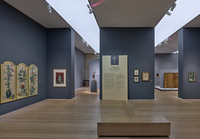
From today’s perspective, the special intellectual and painterly qualities of the two portraits by Astruc and Zola, as well as of the group portrait by Fantin-Latour and the many enchanting floral still lifes in the exhibition, were precisely what irked conservative art critics (fig. 3). In particular, they criticized the mixing of the genres of portraiture and still life, which was still considered lowly. Early on, people sensed what much later Theodor W. Adorno, anticipating Clement Greenberg’s modernist criticism in the 1960s, called the hybridization and fraying of the genres. Manet countered accordingly and is reported to have said: “Still life is the painter’s touchstone.”[1] Astruc also commented on this in 1870: “The genres are becoming more and more intermingled. . . . There is not a mind today that does not refuse the old classification and position in the established order of composition.”[2] What Manet and his friends accomplished with still life and the Impressionists with landscape, abstract painting achieved with pure forms and colors: a revolution and reevaluation in the hierarchy of genres.
After 1872, Astruc ended his career altogether, not as a writer but as an art critic, and from then on was primarily active as a visual artist, discovering his particular talent in sculpture, floral still life, and most especially in portraiture. By the time of his death in 1907, at least twenty-nine of his sculptures had been exhibited at the Paris Salon with many honorable mentions. During his extended stay in Spain in 1872–73, after much persistence, he was able to make a bronze copy of the Baroque sculpture of St. Francis of Assisi (1663–64) in the Toledo Cathedral treasury, now attributed to the Spanish artist Pedro de Mena. It is an astonishing figure, which is represented in the exhibition by a replica of bronze, copper, and glass that existed in Astruc’s day (fig. 4). It appears to today’s eyes as somewhat odd—already postmodern, even in the context of early Impressionism, in the way that the mystical religious fervor of the Counter-Reformation is imitated and even increased. Yet it was precisely in its austerity and pathos that it found an enthusiastic audience in Paris in 1874.
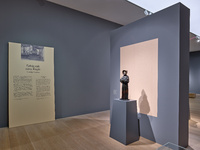
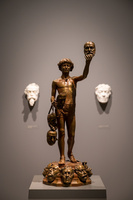
Even more famous was Astruc’s Mask Seller (fig. 5), whose bronze original of 1883 is in the Jardin du Luxembourg in Paris and can be seen in the exhibition in one of the rare smaller bronze replicas of 1886, which were produced in Paris because of its great success. In 2021, the Kunstverein was able to acquire this copy that has much of the character of the original sculpture. The sculpture, which portrays a youth selling masks with the countenances of famous Parisian artists and writers, is, appropriately, a stylistic amalgam of antique, Renaissance, and modern styles, a veritable French pantheon of nineteenth-century art.
Finally, it remains to ask critically where the women are in this male society. They appear in the paintings as prostitutes, coveted objects, mistresses, girlfriends, and fashionably dressed wives in modern interiors. Here, too, Zacharie Astruc provided prescient gender studies in light of the fact that, after all, twenty-six percent of the watercolors and nine percent of the paintings in the Paris Salon were by women. His independent Salon publication of 1870 appeared under the title “Décaméron féminin” and exclusively discussed the works of women artists.[3] Significantly, he did not see their work as being on a lower level than that of their male counterparts, but at best as having a different poetry.
Notes
Translations by the author.
[1] “La nature morte est la pierre de toucher du peintre,” in Jacques-Émile Blanche, Propos de peintre. De David à Degas (Paris: Émile-Paul frères, 1919), 43.
[2] “De plus en plus, les genres sont confondus. . . . Il n’est pas d’esprit, aujourd’hui, qui n’échappe à l’ancient classement et ne se refuse au numéro d’ordre établi pour les series de composition,” in Zacharie Astruc, “Le Salon de 1870,” L’Écho des Beaux–Arts, June 12, 1870, 1.
[3] Zacharie Astruc, “Décaméron féminin,” L’Écho des Beaux–Arts, June 26, 1870, 1. See also the essay of Sharon Flescher in the catalogue of the exhibition, 36f.